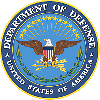
| UNIVERSITY OF OKLAHOMA |
| Media and the Military Getting More Bang for the Buck |
 |
|
||||||||

For more information contact the following: Eric Durie John Elolf Dina McKain A. Frank Patterson Last updated February 27, 2002 |
Since the terrorist attacks on September 11, public support for the military has increased dramatically. In December, members of the Department of Defense and the entertainment industry formed a committee to discuss the development of military-related
trailers, public service announcements, and the distribution of movies to deployed military members. Since then, the film industry has released or will release several military-related movies, television news has been predominately positive, and
television networks such as USA and TNT have released or will release television series featuring military or former military members in simulated combat environments. These shows are just the beginning of the potential for positive coverage during the current crisis and beyond. The formation of this committee represents a commitment between the military and the entertainment industry. It is important for the military and the media to work together to inform the American public, according to Hooper (1982). "The media have played an invaluable part in maintaining the link between the military and society and during the last 10 years the focus on the military way of life, particularly by television, has done much to correct the misconceptions of the past" (p. 210). An example of how the media can turn public opinion against the military if not allowed to accurately follow developing conflicts (Hooper, 1982) was realized during the Vietnam War. After the Tet Offensive, the American media declared victory for the North Vietnamese Army. This led to increased public dissent and disapproval of the U.S. military campaign. Since then, the military has allowed the media increased access during operations with some restrictions because of security considerations. During Operation Desert Shield/Storm, the media were allowed to videotape the launch of Tomahawk cruise missiles from a U.S. Navy ship in the Persian Gulf. Hickey (2002), explained the importance of allowing the media access to military operations such as this.
The purpose of this study is to develop a method to determine the media source (i.e., movies, television, radio, Internet, newspapers and magazines) that provides the military with the most positive coverage as perceived by the general U.S. population. There is no shortage of research relating to the advantages and disadvantages of each media outlet. However, there is no significant body of work relating to which media portrays the best military image. Through a review of existing literature and research, we have uncovered two theories we will apply to this problem. We will use the agenda-setting and cultivation theories to determine the most effective media type for promoting a positive military image. The basic premise of agenda-setting is that the media plays an important role in shaping the public's perception of reality. In short, the media do not tell us what to think; they tell us what to think about (Cohen, 1963). Cultivation theory maintains that television influences our reality and changes our perceptions about the world we live in (Infante, Rancer & Womack, 1997, p. 383). Through correct application of these two theories, we hope to determine the media type that provides the most extensive, positive support for the military and its job of protecting the country and its national interests. |